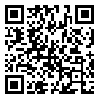Fri, Dec 26, 2025
Volume 34, Issue 2 (2-2024)
JHNM 2024, 34(2): 133-142 |
Back to browse issues page
Download citation:
BibTeX | RIS | EndNote | Medlars | ProCite | Reference Manager | RefWorks
Send citation to:



BibTeX | RIS | EndNote | Medlars | ProCite | Reference Manager | RefWorks
Send citation to:
Naghdipour Mirsadeghi M, Rafiei Sorouri Z, Mansour Ghanaie M, Hosseinzadeh F, Farzadi S, Biazar G et al . Not-prescribed Use of Herbal Products and Supplements Among Pregnant Women. JHNM 2024; 34 (2) :133-142
URL: http://hnmj.gums.ac.ir/article-1-2305-en.html
URL: http://hnmj.gums.ac.ir/article-1-2305-en.html
Misa Naghdipour Mirsadeghi1 

 , Zahra Rafiei Sorouri1
, Zahra Rafiei Sorouri1 

 , Mandana Mansour Ghanaie2
, Mandana Mansour Ghanaie2 

 , Fatemeh Hosseinzadeh1
, Fatemeh Hosseinzadeh1 

 , Sara Farzadi1
, Sara Farzadi1 

 , Gelareh Biazar *3
, Gelareh Biazar *3 

 , Seyed Mohamadreza Tabatabaei Taher4
, Seyed Mohamadreza Tabatabaei Taher4 




 , Zahra Rafiei Sorouri1
, Zahra Rafiei Sorouri1 

 , Mandana Mansour Ghanaie2
, Mandana Mansour Ghanaie2 

 , Fatemeh Hosseinzadeh1
, Fatemeh Hosseinzadeh1 

 , Sara Farzadi1
, Sara Farzadi1 

 , Gelareh Biazar *3
, Gelareh Biazar *3 

 , Seyed Mohamadreza Tabatabaei Taher4
, Seyed Mohamadreza Tabatabaei Taher4 


1- Assistant Professor, Reproductive Health Research Center, Department of Obstetrics & Gynecology, Alzahra Hospital, School of Medicine, Guilan University of Medical Sciences, Rasht, Iran.
2- Associate Professor, Reproductive Health Research Center, Department of Obstetrics and Gynecology, Alzahra Hospital, School of Medicine, Guilan University of Medical Sciences, Rasht, Iran.
3- Associate Professor, Anesthesiology Research Center, Department of Anesthesiology, Alzahra Hospital, Guilan University of Medical Sciences, Rasht, Iran. ,gelarehbiazar1386@gmail.com
4- MD Student of Medicine, Student Research Committee, School of Medicine, Guilan University of Medical Sciences, Rasht, Iran.
2- Associate Professor, Reproductive Health Research Center, Department of Obstetrics and Gynecology, Alzahra Hospital, School of Medicine, Guilan University of Medical Sciences, Rasht, Iran.
3- Associate Professor, Anesthesiology Research Center, Department of Anesthesiology, Alzahra Hospital, Guilan University of Medical Sciences, Rasht, Iran. ,
4- MD Student of Medicine, Student Research Committee, School of Medicine, Guilan University of Medical Sciences, Rasht, Iran.
Abstract: (1103 Views)
Introduction: Not-prescribed use (NPU) of herbal products and supplements during pregnancy is a potent risk for both mother and fetus and a big challenge for anesthesiologists. However, little is known about this topic in Guilan Province, Iran.
Objective: This study aimed to determine how pregnant women take supplements and herbal medications.
Materials and Methods: This analytical cross-sectional study was conducted in 2022. Eligible pregnant women enrolled in the survey, and a checklist containing items about maternal demographic data and the maternal pattern of herbs and supplements used during pregnancy was filled out through a face-to-face interview. Multivariate logistic regression, the Chi-square, and the Mann-Whitney U statistical tests were used to analyze the data.
Results: The data from 682 women were analyzed. A total of 488 women (71.6%) were less or equal to 30 years old; 498(73%) lived in urban areas; 508(74.5%) were homemakers; 444(65.1%) had under-diploma or diploma education, 292(42.8%) were gravid one or 251(36.8%) gravid two. In addition, 25.1% reported using at least one herbal remedy during pregnancy, and 90% took supplements; 0.7% had NPU of supplements and 93.6% took herbal products. About 10% did not take any supplements. Iron (23.3%) and folic acid (23.1%) were the most frequently taken supplements, and thyme (20.2%) and mint (17.5%) were the most commonly taken herbs. Using logistic regression, we found that urbanization (OR=1.91, 95% C, 1.6%, 3.14%, P=0.01), employment (OR=2.21, 95% CI; 1.46%, 3.33%, P=0.0001), and higher gravidity (OR=2.03, 95% CI; 1.22%, 3.36%, P=0.006) increases the probability of consuming supplements and herbal products during pregnancy.
Conclusion: The lack of physicians’ supervision of the herbal therapy process among pregnant women in an academic center was worrying. However, most women received the supplements based on healthcare professionals’ advice. A few women did not take essential supplements.
Objective: This study aimed to determine how pregnant women take supplements and herbal medications.
Materials and Methods: This analytical cross-sectional study was conducted in 2022. Eligible pregnant women enrolled in the survey, and a checklist containing items about maternal demographic data and the maternal pattern of herbs and supplements used during pregnancy was filled out through a face-to-face interview. Multivariate logistic regression, the Chi-square, and the Mann-Whitney U statistical tests were used to analyze the data.
Results: The data from 682 women were analyzed. A total of 488 women (71.6%) were less or equal to 30 years old; 498(73%) lived in urban areas; 508(74.5%) were homemakers; 444(65.1%) had under-diploma or diploma education, 292(42.8%) were gravid one or 251(36.8%) gravid two. In addition, 25.1% reported using at least one herbal remedy during pregnancy, and 90% took supplements; 0.7% had NPU of supplements and 93.6% took herbal products. About 10% did not take any supplements. Iron (23.3%) and folic acid (23.1%) were the most frequently taken supplements, and thyme (20.2%) and mint (17.5%) were the most commonly taken herbs. Using logistic regression, we found that urbanization (OR=1.91, 95% C, 1.6%, 3.14%, P=0.01), employment (OR=2.21, 95% CI; 1.46%, 3.33%, P=0.0001), and higher gravidity (OR=2.03, 95% CI; 1.22%, 3.36%, P=0.006) increases the probability of consuming supplements and herbal products during pregnancy.
Conclusion: The lack of physicians’ supervision of the herbal therapy process among pregnant women in an academic center was worrying. However, most women received the supplements based on healthcare professionals’ advice. A few women did not take essential supplements.
Article Type : Research |
Subject:
General
Received: 2024/02/24 | Accepted: 2024/02/21 | Published: 2024/02/21
Received: 2024/02/24 | Accepted: 2024/02/21 | Published: 2024/02/21
Send email to the article author
| Rights and permissions | |
 | This work is licensed under a Creative Commons Attribution-NonCommercial 4.0 International License. |



